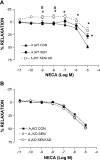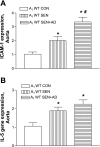Involvement of A1 adenosine receptors in altered vascular responses and inflammation in an allergic mouse model of asthma
- PMID: 20400685
- PMCID: PMC2904134
- DOI: 10.1152/ajpheart.01090.2009
Involvement of A1 adenosine receptors in altered vascular responses and inflammation in an allergic mouse model of asthma
Abstract
Poor lung function and respiratory disorders like asthma have a positive correlation with the development of adverse cardiovascular events. Increased adenosine levels are associated with lung inflammation that could lead to altered vascular responses and systemic inflammation. We hypothesized that asthmatic lung inflammation has systemic effects through A(1) adenosine receptors (A(1)AR) and investigated the effects of aerosolized adenosine on vascular reactivity and inflammation, using A(1)AR knockout (A(1)KO) and corresponding wild-type (A(1)WT) mice that were divided into three experimental groups each: control (CON), allergen sensitized and challenged (SEN), and SEN + aerosolized adenosine (SEN + AD). Animals were sensitized with ragweed (200 microg ip; days 1 and 6), followed by 1% ragweed aerosol challenges (days 11 to 13). On day 14, the SEN + AD groups received one adenosine aerosol challenge (6 mg/ml) for 2 min, and aortae were collected on day 15. 5'-N-ethylcarboxamidoadenosine (NECA; nonselective adenosine analog) induced concentration-dependent aortic relaxation in the A(1)WT CON group, which was impaired in the A(1)WT SEN and SEN + AD groups. All groups of A(1)KO mice showed similar (no significant difference) concentration-dependent relaxation to NECA. The A(1)WT SEN and SEN + AD groups had a significantly higher contraction to selective A(1) agonist 2-chloro-N(6)-cyclopentyladenosine (CCPA) compared with the CON group. Western blot data showed that aortic A(1)AR expression was significantly increased in WT SEN and SEN + AD mice compared with CON mice. Gene expression of ICAM-1 and IL-5 was significantly increased in allergic A(1)WT aorta and were undetected in the A(1)KO groups. A(1)WT allergic mice had significantly higher airway hyperresponsiveness (enhanced pause) to NECA, with adenosine aerosol further enhancing it. In conclusion, allergic A(1)WT mice showed altered vascular reactivity, increased airway hyperresponsiveness, and systemic inflammation. These data suggest that A(1)AR is proinflammatory systemically in this model of allergic asthma.
Figures






Similar articles
-
Adenosine receptors and vascular inflammation.Biochim Biophys Acta. 2011 May;1808(5):1429-34. doi: 10.1016/j.bbamem.2010.08.024. Epub 2010 Sep 9. Biochim Biophys Acta. 2011. PMID: 20832387 Free PMC article. Review.
-
Adenosine-mediated alteration of vascular reactivity and inflammation in a murine model of asthma.Am J Physiol Heart Circ Physiol. 2008 May;294(5):H2158-65. doi: 10.1152/ajpheart.01224.2007. Epub 2008 Feb 29. Am J Physiol Heart Circ Physiol. 2008. PMID: 18310516 Free PMC article.
-
Effect of a specific and selective A(2B) adenosine receptor antagonist on adenosine agonist AMP and allergen-induced airway responsiveness and cellular influx in a mouse model of asthma.J Pharmacol Exp Ther. 2007 Mar;320(3):1246-51. doi: 10.1124/jpet.106.112250. Epub 2006 Dec 11. J Pharmacol Exp Ther. 2007. PMID: 17159162
-
Absence of adenosine-mediated aortic relaxation in A(2A) adenosine receptor knockout mice.Am J Physiol Heart Circ Physiol. 2009 Nov;297(5):H1655-60. doi: 10.1152/ajpheart.00192.2009. Epub 2009 Sep 11. Am J Physiol Heart Circ Physiol. 2009. PMID: 19749167 Free PMC article.
-
Adenosine receptors and asthma.Handb Exp Pharmacol. 2009;(193):329-62. doi: 10.1007/978-3-540-89615-9_11. Handb Exp Pharmacol. 2009. PMID: 19639287 Free PMC article. Review.
Cited by
-
Mild allergic airways responses to an environmental mixture increase cardiovascular risk in rats.Toxicol Sci. 2023 Jan 31;191(1):106-122. doi: 10.1093/toxsci/kfac112. Toxicol Sci. 2023. PMID: 36269214 Free PMC article.
-
Targeting purinergic receptors to attenuate inflammation of dry eye.Purinergic Signal. 2023 Mar;19(1):199-206. doi: 10.1007/s11302-022-09851-9. Epub 2022 Feb 26. Purinergic Signal. 2023. PMID: 35218451 Free PMC article. Review.
-
Adenosine Receptors As Drug Targets for Treatment of Pulmonary Arterial Hypertension.Front Pharmacol. 2017 Dec 4;8:858. doi: 10.3389/fphar.2017.00858. eCollection 2017. Front Pharmacol. 2017. PMID: 29255415 Free PMC article. Review.
-
Purinergic receptors in ocular inflammation.Mediators Inflamm. 2014;2014:320906. doi: 10.1155/2014/320906. Epub 2014 Jul 14. Mediators Inflamm. 2014. PMID: 25132732 Free PMC article. Review.
-
Adenosine receptors and vascular inflammation.Biochim Biophys Acta. 2011 May;1808(5):1429-34. doi: 10.1016/j.bbamem.2010.08.024. Epub 2010 Sep 9. Biochim Biophys Acta. 2011. PMID: 20832387 Free PMC article. Review.
References
-
- Abebe W, Mustafa SJ. A1 adenosine receptor-mediated Ins(1,4,5)P3 generation in allergic rabbit airway smooth muscle. Am J Physiol Lung Cell Mol Physiol 275: L990–L997, 1998 - PubMed
-
- Ansari HR, Nadeem A, Talukder MA, Sakhalkar S, Mustafa SJ. Evidence for the involvement of nitric oxide in A2B receptor-mediated vasorelaxation of mouse aorta. Am J Physiol Heart Circ Physiol 292: H719–H725, 2007 - PubMed
-
- Asquith KL, Ramshaw HS, Hansbro PM, Beagley KW, Lopez AF, Foster PS. The IL-3/IL-5/GM-CSF common receptor plays a pivotal role in the regulation of Th2 immunity and allergic airway inflammation. J Immunol 180: 1199–1206, 2008 - PubMed
-
- Belardinelli L, Linden J, Berne RM. The cardiac effects of adenosine. Prog Cardiovasc Dis 32: 73–97, 1989 - PubMed
-
- Blackburn MR, Kellems RE. Adenosine deaminase deficiency: metabolic basis of immune deficiency and pulmonary inflammation. Adv Immunol 86: 1–41, 2005 - PubMed
Publication types
MeSH terms
Substances
Grants and funding
LinkOut - more resources
Full Text Sources
Medical
Molecular Biology Databases
Research Materials
Miscellaneous

